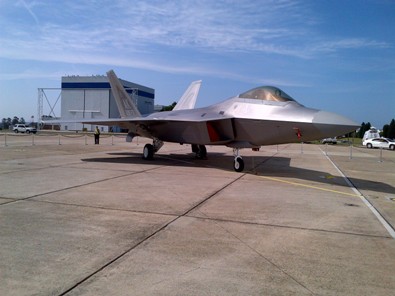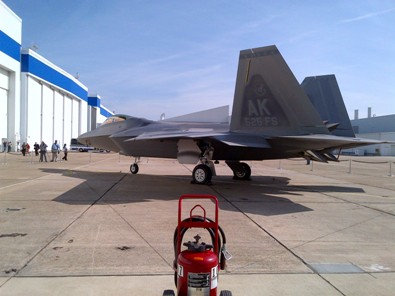The US Air Force has formally taken delivery of its last F-22 Raptor air dominance fighter from airframer Lockheed Martin.
In an elaborate ceremony held at Lockheed's Marietta, Georgia factory on 2 May, the company's F-22 programme manager Jeff Babione handed over a ceremonial key for the last Raptor to US Air Force (USAF) Chief of Staff Gen Norton Schwartz, who then handed it over to pilot Lt Col Paul "Max" Moga, who then passed it onto his crew chief, Staff Sgt Damon Crawford.
In the audience were a host of industry and USAF dignitaries including Lockheed chief executive Bob Stevens, and Gens Mike Hostage, Edward Rice and Gary North, among others.
"The delivery represents an important element in our overall modernisation effort," Schwartz says. "We continue to focus on ensuringthat these capabilities will help shape the future security environment, not just respond to them."
The delivery of tail number 10-4195 marks the completion of 187 production jets and eight pre-production test aircraft. A far cry from the 750 jets the USAF originally envisioned. The USAF took ownership of the jet with the signing of Form DD-250.
 |
|---|
| © Dave Majumdar/Flightglobal |
Although the last aircraft is being delivered on Thursday, the jet will be flown to its new home station at Joint Base Elmendorf-Richardson on 4 May along with Tail 10-4193. Tail 4195 will serve as the flagship for the 525th Fighter Squadron (FS) and 4193 will become the flagship for the 3rd Wing.
"If someone had told me in 2004, when I first started flying the Raptor, that I would have the honour of flying the last production jet out of Marietta, I'd have never believed them," says Moga, commander of 525th FS, who will fly the jet to Alaska. 3rd Wg Cdr Col Dirk "Stuff" Smith will fly tail 4193 Elemendorf-Richardson.
Moga praises those who built the powerful twin-engined stealth fighter.
"The F-22 weapon system is a testament to this country's industrial strength, technological power and aviation ingenuity. Any line worker, engineer or supervisor that was involved in building the Raptor should feel an immense amount of pride in what they have accomplished. It is far and away the most lethal fighter aircraft ever built - a fact that will unfortunately, but most certainly, be proven in combat some day," he says. "Rest assured...the F-22 has and will save lives."
Although Tail 4195 is the last Raptor to be built, the F-22's story is not over. Schwartz reiterated the USAF's commitment to continue upgrading the F-22 because it is essential to defeating anti-access/area-denial threats.
The USAF is continuing to field upgraded jets with the new Increment 3.1 modernisation package, which greatly increases the jet's air-to-surface punch.
Increment 3.1 adds synthetic aperture radar (SAR) ground mapping capability with which the Raptor will be able to select its own ground targets. It also allows the Raptor to carry eight satellite-corrected inertially-guided 113kg (250lb) Small Diameter Bombs (SDB). The upgrade allows a pilot to manually designate two ground targets at a time using two weapons each, which enables an F-22 to hit four separate targets with its eight weapons.
The USAF's previous Increment 2 configuration enabled each aircraft to strike two fixed targets using its two 454kg (1,000lb) Joint Direct Attack Munition satellite-corrected, inertially guided bombs.
The configuration also provides for improved electronic attack of enemy air defences and an upgraded geo-location capability.
"Currently, 10 aircraft have received the Increment 3.1 upgrade and by the end of 2012 we will have 23 aircraft retrofitted with the Increment 3.1 capabilities," says Col John Williams, chief of the F-22 modernisation branch at the USAF Aeronautical Systems Center. "The current plan calls for all combat-coded aircraft to be retrofitted with the Increment 3.1 upgrade."
 |
|---|
| © Dave Majumdar/Flightglobal |
Given that only a handful of jets in Alaska have the new capability installed, the USAF has not had much time to gauge just how much of an impact the new upgrades will have.
"From an operational perspective, we have gotten very limited feedback as the capability is in the initial fielding stage with just 10 aircraft retrofitted to date," Williams says. "The feedback that we have gotten from operational testing is the capabilities are a game changer."
Moga, whose squadron flies some of the modernised jets, concurs. "The capabilities this incremental upgrade brings are a complete game-changer for the F-22, making it even more lethal and survivable in combat," he says.
Every Raptor from tail number 03-4045 through 10-4195 will be upgraded with Increment 3.1, according to Air Combat Command (ACC).
In the coming years, the F-22 will become more lethal still.
In 2014, the USAF will start to field Increment 3.2A. The software-only modification "incorporates new electronic protection techniques and improves the situational awareness of the pilot with the addition of new combat identification techniques", Williams says. It will also correlate data from the Link 16 data-link and fuse it with the F-22's integrated sensors.
That effort will be followed up with an Increment 3.2B upgrade. A Milestone B decision to go ahead with the procurement of Increment 3.2B is planned for December 2012, Williams says. "Kit procurement begins in fiscal year [2016] with kit deliveries in [the third quarter of] fiscal year [2017] and initial installations completed in [the first quarter of fiscal year [2018]," he says.
Increment 3.2B is a hardware and software upgrade that will fully incorporate the
AIM-120D and AIM-9X air-to-air missiles in addition to further upgraded geo-location and electronic protection capabilities.
But according to a recent Government Accountability Office (GAO) report, it will no longer add the capability to independently re-target eight SDBs at eight separate targets or an automatic ground collision avoidance system (Auto-GCAS). A USAF Scientific Advisory Board study on the Raptor's ongoing oxygen system woes has recommended that an Auto-GCAS be implemented.
Increment 3.2B is a much more complicated upgrade than the previous efforts.
"We will be implementing a new enhanced stores management system, increasing the ability of the aircraft to communicate with the weapons," Williams says. "This change will provide a common split-bus architecture for the Block 30/35 aircraft to support the increased communication requirements of newer weapon systems."
However, the USAF cannot wait until 2017 to launch its newest air-to-air weapons from the Raptor. The service is planning to add a "rudimentary" capability to carry both the AIM-9X and AIM-120D before Increment 3.2B is completed.
The AIM-120D will be added first in Update 4, which the service plans to release to the fleet in 2013. The AIM-9X will be added in Update 5, which is set for a 2015 release. "The AIM-9X effort in Update 5 also serves as a risk reduction activity for Increment 3.2B," Williams says.
Every aircraft from Tail 03-4045 onwards will receive Increment 3.2A and B, says ACC. According to a recent Government Accountability Office report, the cost of the Raptor upgrade programme will total about $9.7 billion.
A further update called Increment 3.2C has recently been renamed Increment 3.3, but the capabilities that it might include have not yet been defined. Williams says it will focus on making sure the Raptor remains compatible with new air traffic control systems.
"The effort will be focused on maintaining airspace access and endeavour to include all of the current airspace mandates like Mode S and Mode 5 as well as other FAA/ICAO mandated requirements," he says.
The F-22 System Program Office is still working on trying to graft an open systems architecture to the jet's computers.
"We have been in discussions with companies across the defence industry and, based on these discussions, we recently released a request to [Lockheed Martin] to identify 10 potential alternatives to incrementally open up the F-22 avionics architecture," Williams says. "It is our intent for the government with assistance from outside experts to select the most promising alternatives and award a contract later this year to demonstrate these candidates."
Babione says Lockheed is helping the USAF define the requirements for the open-systems architecture system. It will not be just Lockheed that will participate in the effort, but rather a wide industry consortium will participate, he says.
The addition of open systems architecture could open doors to as of yet unforeseen upgrade possibilities.
Source: Flight International



















